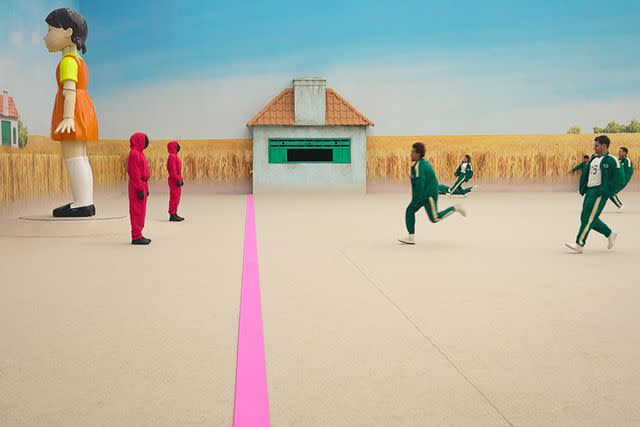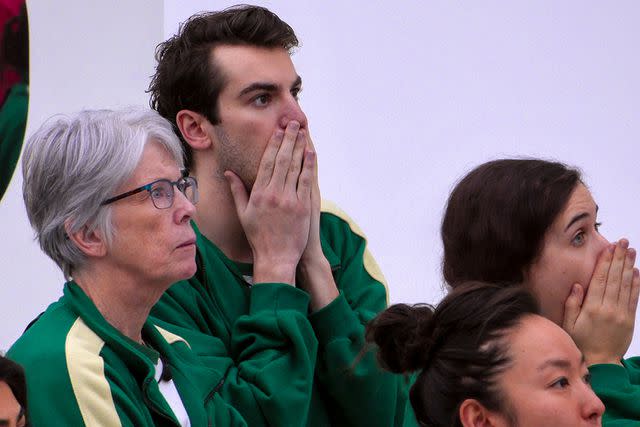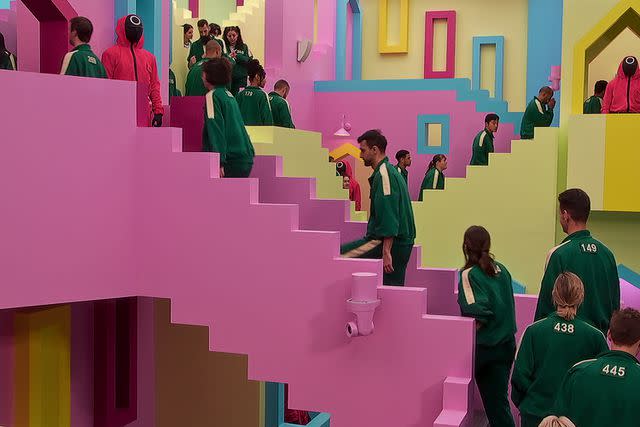Attention all players: The “Squid Game” reality show is actually good
- Oops!Something went wrong.Please try again later.
The Netflix reality show serves up palpable suspense and authentic drama.
When it comes to dramatic stakes, it doesn’t get much higher than life or death. In Netflix’s hit Korean drama Squid Game, 456 desperate debtors competed to get rich — and all but one of them died trying. So, when the streamer announced last year that it was doing a reality TV competition series based on Hwang Dong-hyuk’s brutal survival series — featuring 456 real folks competing for $4.56 million, the largest cash prize in TV history — the reaction was, at best, skeptical. Without the threat of a bullet to the head, aren’t games like marbles and Red Light, Green Light just… child’s play?
Squid Game had no shortage of twists, yet this might be the biggest one of all: With its eclectic cast and inventive updates to the original, Squid Game: The Challenge manages to serve up palpable suspense and authentic human drama without murdering a single contestant.
Filmed in England on meticulously recreated sets, Squid Game: The Challenge bears all the visual hallmarks of the original: Players in green and white sweatsuits snake their way up candy-colored, M.C. Escher-esque stairways to get to challenges — including a tense (though bloodless) round of Red Light, Green Light, featuring a menacing replica of the series’ giant robot doll. Contestants sleep on minimalist metal bunkbeds in a cavernous dormitory and are escorted by anonymous “guards” wearing pink jumpsuits and creepy black metal masks. And after every game, they’re tempted by a giant, see-through piggy bank that slowly fills with prize money as players are eliminated.

Courtesy of Netflix
Players race across the finish line in 'Squid Game: The Challenge'The diverse group of 456 players spans a variety of ages, races, nationalities, and occupations. Though none appear to be in as dire straits as the fictional contestants, the Challenge players all have plans for that multi-million-dollar jackpot: Helping a child with special needs; breaking the cycle of generational poverty; finally being able to retire.
Technically, the challenges are the star of Squid Game, but even the glass bridge spectacle would fall flat if viewers didn’t care about the people trying to cross it. Challenge producers clearly know that casting is the key to any reality show’s success, and they’ve pulled together a sizable and varied selection of folks who sort nicely into classic reality TV archetypes: The everyman, the hero, the underdog, the dark horse, the villain. Prepare to be deeply invested in Trey (No. 301), a lanky delivery driver/aspiring actor from Chicago playing with his mom, Leann (No. 302), a no-nonsense former athlete. Other standout players in the first five episodes include Bryton (No. 432), a buff student who says things like, “Sympathy, that’s only a weakness”; Jada (No. 97), a confident marketing coordinator from New Jersey; and Dani (No. 134), a diminutive blonde who’s used to being underestimated. Here, extra screen time is no guarantee of safety. Your favorite is as likely to be eliminated as anyone — but the show skillfully highlights new protagonists to root for (and against) as the numbers dwindle.

Courtesy of Netflix
Leann and Trey in 'Squid Game: The Challenge'With death off the table as a motivator, producers intensify the psychological pressure on their Squid Game players through additional “tests of character” and strategic tweaks to the original games. Much of these changes force contestants to reach an agreement about something important — a situation that never fails to generate drama. Cliques form and shift in the lead-up to games, as players are often required to betray or align with others in front of everyone. Selflessness usually isn’t rewarded, nor does selfishness guarantee safety, and it’s fascinating to watch the unexpected ways these opposing sentiments come into play. Nothing on TV — scripted or reality — has stressed me out more in recent months than watching poor Spencer (No. 299) navigate the Ppogi (honeycomb cookie) challenge. When the earnest, anxious software engineer is unexpectedly put in a leadership position, he’s all but undone by the competing pressures from his team and his rivals.
Emotions run high in this real-life Squid Game — in part, no doubt, because contestants are stressed, exhausted, and probably a little hungry. (Like their fictional counterparts, players are fed somewhat indistinguishable meals delivered in rectangular tins, though opportunities for “treats” do arise.) The reality show made headlines earlier this year when several media outlets published complaints from participants about “inhumane” conditions — particularly bitter cold during the Red Light, Green Light challenge — and “rigged” games. (Netflix denied allegations of rigging. The streamer confirmed that three players received medical attention and said the show took “all the appropriate safety precautions." Britain’s Health and Safety Executive performed an evaluation on the production but reportedly closed the case.)
Certainly, the players do appear to be cold during the opening challenge, and the accommodations are spare at best. But friends, if you sign up for a reality TV competition in the year of our Lord 2023 — especially one based on a gleefully savage Korean survival drama in which all but one contestant dies — surely it can’t come as a surprise if the conditions are unpleasant? Reality show contracts are notoriously explicit about the myriad discomforts — emotional and physical — that participants may experience, and presumably no one who appeared on Squid Game: The Challenge did so without signing on the dotted line. (Side note: There are 11 mental health professionals listed in the credits.)

Courtesy of Netflix
Players head to their next event on 'Squid Game: The Challenge'Forgive the digression. The show’s attention to detail is admirable, but some attempts to reproduce features from the original just feel silly. When players are eliminated, an ink pack underneath their shirt explodes, leaving a paintball-like splatter. It’s a clever (and relatively tasteful) nod to how players are eliminated in the scripted drama — but was it really necessary to have players fall over “dead” when their ink pack bursts? Nor did we need the “control room” filled with guards watching prop monitors and pushing prop buttons on prop consoles. Having the contestants film some of their confessionals in grim interrogation rooms is also a bit of overkill.
These contrived, cosmetic embellishments undercut the legitimate emotional tension generated by the many folks striving for that giant pile of cash in that piggy bank’s belly. “Who’s not in debt?” asks Starla, a probation officer (No. 318). “What’s that like, to be able to pay off your house? What’s that like, to be able to pay off your car?” The stakes may not be life or death, but they are very real. Grade: B+
Squid Game: The Challenge premieres Wednesday, Nov. 22, on Netflix.
Sign up for Entertainment Weekly's free daily newsletter to get breaking TV news, exclusive first looks, recaps, reviews, interviews with your favorite stars, and more.
Related content:
Green light! Watch the first trailer for Netflix's Squid Game reality show
Squid Game creator addresses reality spin-off: 'I know there are some concerns'
Read the original article on Entertainment Weekly.

